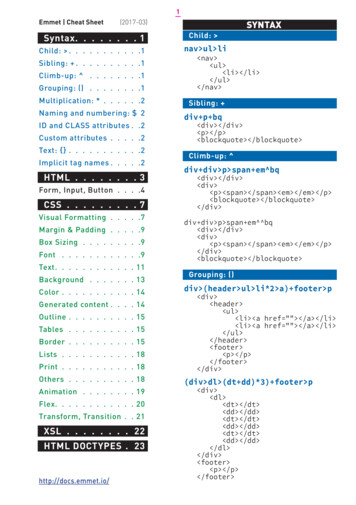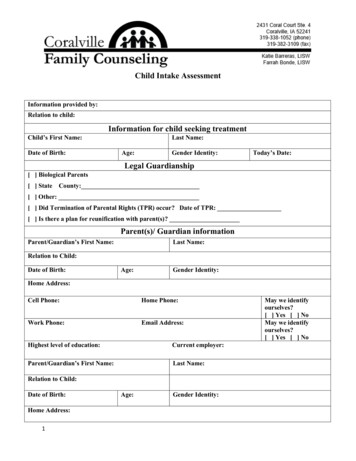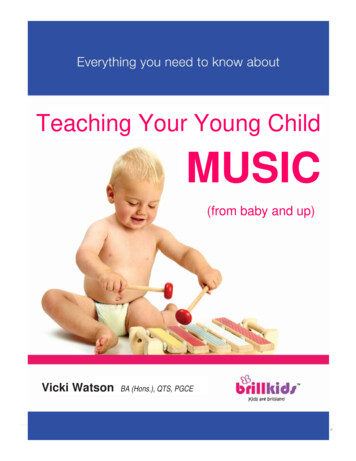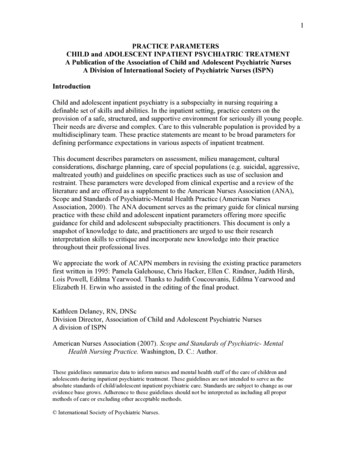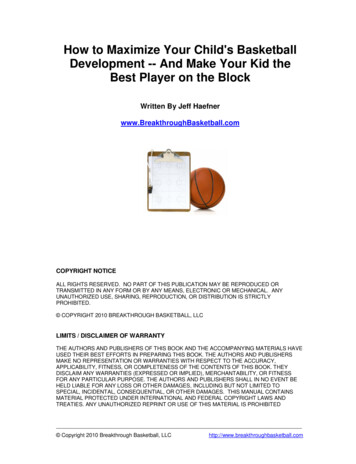
Transcription
Pag e 1How to Maximize Your Child's BasketballDevelopment -- And Make Your Kid theBest Player on the BlockWritten By Jeff Haefnerwww.BreakthroughBasketball.comCOPYRIGHT NOTICEALL RIGHTS RESERVED. NO PART OF THIS PUBLICATION MAY BE REPRODUCED ORTRANSMITTED IN ANY FORM OR BY ANY MEANS, ELECTRONIC OR MECHANICAL. ANYUNAUTHORIZED USE, SHARING, REPRODUCTION, OR DISTRIBUTION IS STRICTLYPROHIBITED. COPYRIGHT 2010 BREAKTHROUGH BASKETBALL, LLCLIMITS / DISCLAIMER OF WARRANTYTHE AUTHORS AND PUBLISHERS OF THIS BOOK AND THE ACCOMPANYING MATERIALS HAVEUSED THEIR BEST EFFORTS IN PREPARING THIS BOOK. THE AUTHORS AND PUBLISHERSMAKE NO REPRESENTATION OR WARRANTIES WITH RESPECT TO THE ACCURACY,APPLICABILITY, FITNESS, OR COMPLETENESS OF THE CONTENTS OF THIS BOOK. THEYDISCLAIM ANY WARRANTIES (EXPRESSED OR IMPLIED), MERCHANTABILITY, OR FITNESSFOR ANY PARTICULAR PURPOSE. THE AUTHORS AND PUBLISHERS SHALL IN NO EVENT BEHELD LIABLE FOR ANY LOSS OR OTHER DAMAGES, INCLUDING BUT NOT LIMITED TOSPECIAL, INCIDENTAL, CONSEQUENTIAL, OR OTHER DAMAGES. THIS MANUAL CONTAINSMATERIAL PROTECTED UNDER INTERNATIONAL AND FEDERAL COPYRIGHT LAWS ANDTREATIES. ANY UNAUTHORIZED REPRINT OR USE OF THIS MATERIAL IS PROHIBITED Copyright 2010 Breakthrough Basketball, LLChttp://www.breakthroughbasketball.com
Pag e 2Table of Contents3 Keys to Maximize Player Development . 3Key #1 - Athleticism. 4Key #2 - Basketball Skill . 10Key #3 - Mentality . 13How America's Youth Basketball Slows Development . 18Misconceptions About Coaching . 22How to Develop Your Child's Athleticism, Skill, and Mentality. 24Ages 0 - 2 . 25Ages 2 - 5 . 26Ages 6 - 9 . 28Ages 10 - 14 . 31Ages 14 and Up . 34About Jeff Haefner . 38 Copyright 2010 Breakthrough Basketball, LLChttp://www.breakthroughbasketball.com
Pag e 33 Keys to Maximize Player DevelopmentBasketball development is widely misunderstood by parents and even coaches too. Almostevery parent I meet has the greatest of intentions and some of them think they know a lotabout basketball development -- but when it comes down to it, they know VERY little aboutdeveloping players efficiently and effectively.It's unfortunate that there are so many misconceptions about basketball development andimproving their child's ability.In fact, youth basketball in this country has become surprisingly flawed and ineffective. Thisis why European countries have caught up with us when it comes to basketball. Europeancountries are able to compete with us (and even beat us) with far less athletic players andfewer people to choose from. The truth is that they have a better youth and playerdevelopment system than we do in the United States. They produce highly skilled playersand we produce athletes (because we have a bigger population to choose from and betterfacilities).So what can we learn from this and what can you do as a parent to maximize your child'sdevelopment and give them an edge over the competition?In this report I'm going to dispel the myths and share with you a much better way to developbasketball players.Basketball ability and development comes down the three key and equally important areas:1. Athleticism2. Basketball skill3. MentalityNow this is vital -- you'll notice that I said all three areas are equally important!!This is one of the very common mistakes that I see. Parents, players, and coaches neglect oneor more of these areas. To reach your potential, maximize performance, and make bigimprovements, all three areas must be addressed.It is very very rare that I see players effectively working on all three of those areas. And ifthey do work on all three, they don't do a very good job and/or understand each aspect.Let's talk about how we can improve and develop better players. Copyright 2010 Breakthrough Basketball, LLChttp://www.breakthroughbasketball.com
Pag e 4Key #1 - AthleticismWhat does athleticism really mean? Why is it important? And can you really developathleticism?Let's start by pointing out that I'm using the term "athleticism" loosely. I like to group avariety of related attributes into one group. I usually refer to that group as "athleticism" or"athletic development".Here's a quick summary of what I like to include into the athletic development category: Strength (absolute, maximal, explosive, and speed) of the hands, core, legs, shoulders,and arms.AgilityFoot speed and quickness (forward, backward, side to side, and diagonal)Hand speed and quicknessEnduranceJumpingBalanceMotor coordination - gross motor skills, fine motor skills, eye hand coordination,ambidexterity, accuracy/hand accuracy, spatial awareness, rhythm.Reaction time / mental chronometryFlexibilityProprioception and kinesthesiaForm (running and movement technique)If you have played basketball or know anything about basketball, you will quickly realize thatall these things are critically important to become a good basketball player.Huge books have been written about strength, agility, endurance and every aspect ofathleticism. I don't pretend to understand all aspects of athletic development nor do I expectyou to understand.I do, however, believe it's important for you to somewhat understand WHAT each categorymeans and WHY they are important. Once you have a basic understanding you'll be able touse some of the simple techniques I'll give you to help your child develop athletically andeven come up with your own ways to help your child improve.So let's jump in and briefly cover each aspect of athletic development and explain why theyare important.Strength (Absolute, Maximal, Explosive, and Speed) of the Hands, Core, Legs,Shoulders, and ArmsStrength in regards to sports is highly misunderstood and that's why I like to make a point ofthe "4 types of strength". Basketball players can use their strength in different ways. Copyright 2010 Breakthrough Basketball, LLChttp://www.breakthroughbasketball.com
Pag e 5Absolute strength is the amount of force that one can exert under involuntary musclestimulation. Most people will never undergo involuntary muscle stimulation, so you canignore this and focus on the next three.Maximal strength is the amount of force that one can exert under voluntary effort. Thisstrength quality is seen during a powerlifting competition. Each athlete tries to lift thegreatest amount of weight.Examples of maximal strength training include heavy weight lifting, high-tension isometrics,and strenuous bodyweight movements (ex. one-arm chin-ups). In regards to basketball,positioning yourself in the post and powering up lay ups while getting fouled are examples ofmaximal strength on the basketball court.Explosive Strength is the ability to express significant tension in minimal time. Explosivestrength is considered the strength quality most characteristic of athletic activities. Explosivestrength is developed with fast, powerful muscle actions. Jumping as high as you can is anexample of explosive strength.Speed Strength is the ability to quickly execute an unloaded movement or a movementagainst a relatively small external resistance. Making a crisp pass or shooting the basketballfrom long range are both examples of speed strength.In order to be a GREAT basketball player, you don't need to excel at all 4 types of strength.However you do need to excel (or at least be adequate) in a 2 or more of the areas.Let's take two NBA players to demonstrate why and how these types of strengths can affectyour basketball performance.Shaquille O'Neal possesses superior maximal strength and good explosive strength too. Thisallows him to pass the ball at a high speed and long distance, establish position in the post,and power the ball up for easy baskets in the post. Shaq is a very big and powerful playerthat uses his "maximal strength" to dominate the competition.Kevin Durant is skinny and lacks raw power. He could barely bench press 120 lbs cominginto the NBA. He is NOT strong when it comes to lifting weights and yet he is one of thebest players in the league. The reason Kevin Durant is able to be an elite player is because hehas explosive strength and speed strength. This allows him to make crisp passes, shoot fromlong range, and drive to the basket quickly.It's important to note that some young players do not have the strength to pass the ball farenough, shoot the ball far enough, or move quick enough. Without enough strength toperform these tasks adequately, a player will not be able to compete on the basketball court.I see many young players (and older ones too) that lack the strength to be good basketballplayers. It goes without saying that the more maximal, explosive, and speed strength a playercan develop, the better they will get.A common shortfall in exercise programs is that players put their eggs into one basket. Theyfocus on one area like heavy weight lifting and neglect high rep exercises. As a result the Copyright 2010 Breakthrough Basketball, LLChttp://www.breakthroughbasketball.com
Pag e 6athlete displays tremendous strength but lacks the muscle endurance and explosive strengththat will help them on the basketball court.Michael Jordan, Kobe Bryant, and Bill Russell are some of the best players ever. They allhave incredible maximal, explosive, and speed strength. They are extremely well roundedathletes.Larry Bird had good maximal strength and adequate explosive strength. But generallyspeaking he was one of the least athletic players in the NBA. He became one of the all timegreat players by making up for his lack of speed with superior skill (shooting, passing,footwork) and mentality (basketball smarts, etc). I can't imagine how good he would havebeen with explosive speed and power!AgilityAgility is the ability to change the body's position efficiently, and requires the integration ofisolated movement skills using a combination of balance, coordination, speed, reflexes,strength, endurance and stamina.Agility is very important because it allows you to get more rebounds, play better defense,dribble through traffic, get open, and score points.Players should not neglect the importance of developing agility. It will help them inbasketball and all sports.Foot Speed and QuicknessBasketball is all about getting from one place to another quickly. Foot speed allows you toplay great defense, get more rebounds, get more steals, get open, get to the basket before thedefense can catch you, and much more.The quicker athletes always have the edge. So anything you can do to improve foot speedwill help you on the basketball court.Hand Speed and QuicknessMost trainers neglect hand speed. You might not put this real high on the priority list, but ifyou want to develop an all around athlete, hand speed is part of the equation. If you havequick hands you'll he able to steal the ball more often, play better defense, dribble faster, andpotentially be a more effective scorer.EnduranceEndurance is a huge part of basketball. On more than one occasion I’ve seen less-skilledathletes get more playing time, because they are in better shape. Their endurance allowedthem to play harder than everyone else, which allowed them to be better defensive players,rebounders, and have enough strength to hits shots at the end of the game. Copyright 2010 Breakthrough Basketball, LLChttp://www.breakthroughbasketball.com
Pag e 7Aggression and tenacity is a huge part of rebounding and defense. If you don't have themuscle endurance, heart endurance, and lung endurance, you won't be able to play tenaciousdefense and rebound aggressively for long periods of time. You will simply wear out andyour opponent will win the battle.Vertical LeapI probably don't need to say anything about vertical leap. I think jumping ability does help aplayer but with the crowd pleasing Michael Jordan dunks, jumping has becomeoveremphasized and too much focus is already placed on jumping ability.However, even though most players want to jump higher, they don't know how to developand improve their jumping properly. So we'll address that issue later in this report.BalanceThis is huge! Not enough attention is paid to balance. This is something that can and shouldbe developed at an early age. Basketball is all about balance and footwork. You need greatbalance to play defense, make offensive moves, elude the defense, rebound, and play allaspects of the game.Coaches constantly talk about balance. But how many basketball players and parentsproactively try to improve their child's balance?Motor CoordinationMotor coordination is greatly misunderstood and neglected. This is very important for youthplayers.According to Wikipedia, motor coordination is the combination of body movements createdwith the kinematic (such as spatial direction) and kinetic (force) parameters that result inintended actions. Such movements usually smoothly and efficiently work together. Motorcoordination involves the integration of processes ranging from how muscles interact with theskeletal system to neural processes controlling them both in the spine and the brain.Motor coordination is both genetically inherited and developed through training. It'sparticularly important for young children to be in an environment where they can developstrong motor coordination.This coordination transfers directly into their ability to perform sports activities and playbasketball.A good development program will aid in the development of a child's gross motor skills, finemotor skills, eye hand coordination, ambidexterity, and accuracy (ie: hand striking accuracy).Eye hand coordination and ambidexterity (ability to use both hands) are extremely importanton the basketball court. Almost everything you do requires hand eye coordination (shooting,passing, dribbling, defense, rebounding, etc). Copyright 2010 Breakthrough Basketball, LLChttp://www.breakthroughbasketball.com
Pag e 8The better your motor skills and coordination, the easier it will be for you to master and excelat your basketball skills.Reaction Time (Mental Chronometry)This is another area that is neglected yet improves a player’s ability. Coaches often refer tothis as "mental quickness".According to Wikipedia, reaction time is the elapsed time between the presentation of asensory stimulus and the subsequent behavioral response. It indicates how fast the thinker canexecute the mental operations needed by the task at hand. The behavioral response istypically a button press but can also be an eye movement, a vocal response, or some otherobservable behavior.If a player can react quick (has good "reaction time") they will appear quicker on thebasketball court. I have seen some physically slow footed players make up for it with mentalquickness and reaction time. One on one defense is a great example where reaction time iscritical. If you have good reaction time it will be easier for you to stay in front of youropponent and keep them from getting to the basket.FlexibilityMuscle flexibility is important because it reduces the risk of injury, allows for a greater rangeof motion (ex: so players can reach a few inches further to get the ball), and allows forimproved jumping and explosiveness.In a good athletic development program, flexibility should not be neglected.Proprioception and KinesthesiaIf you've sprained your ankle and worked with a good physical therapist you've probablyheard this word before.This is because when you sprain your ankle badly, you damage your proprioceptors and loseyour ability to balance effectively on that foot.Proprioceptors are specialized sensory receptors on nerve endings found in muscles, tendons,joints, and the inner ear. These receptors relay information about motion or position andmake us aware of our own body position and movement in space. Proprioceptors detect subtlechanges in movement, position, tension, and force, within the body.Proprioception is the sense of the relative position of neighboring parts of the body.This is important on the basketball court for many reasons. For one, it keeps you fromgetting injured. Proprioceptors can trigger certain protective reflexes. The "stretch reflex,"for example, is activated when the proprioceptors sense too much stretch or force on a muscleor tendon. Copyright 2010 Breakthrough Basketball, LLChttp://www.breakthroughbasketball.com
Pag e 9This is why it's very common for athletes to re-sprain ankles. Once their ankle is sprained,they need time and rehab to build up their proprioceptors.In addition to preventing injury, proprioception allows players to control their body extremelywell. You often hear sports broadcasters say things like "Derrick Rose has incredible bodycontrol and ability to finish at the basket". Well part of the reason these players have greatbody control is because they have highly developed proprioception.Form (Running and Movement Technique)Basketball players, runners, and athletes can become more athletic simply by improving theirform/technique for stopping, jumping, running, squatting, lunging, and many other movementpatterns. And most importantly, using proper technique will reduce the likelihood of injury.With proper running form you can get faster. Few athletes work on their form but it's an areathat can improve their athleticism.Final Thoughts on Athletic DevelopmentI hope your head is not spinning after all of that. Don't worry, we'll give you a fairly simpleplan to work on all those areas.The most important thing is you realize that athletic development is tremendously important,there is a lot to it, and it should not be too focused in one specific area. You want wellrounded athletes that have a solid foundation that gives them a chance to succeed and thrivein whatever sport they choose. Copyright 2010 Breakthrough Basketball, LLChttp://www.breakthroughbasketball.com
Pag e 10Key #2 - Basketball SkillYet again, there is a lot of confusion and misconception about basketball skill.For example, most parents believe that if they put their kids in a basketball league at a youngage and have them play a lot of games, they will become skilled players. That is a hugemisconception.If you think about it, how many times does a player get to dribble and shoot the ball in a 5 on5 game? They might get 10 shots in a game. That's not very much practice!This comes down to simple math. If you play a 32 minute game with 10 other players (andyou assume everyone touches the ball evenly and plays the entire game), you get to touch theball for 3 minutes and 20 seconds. That's not much time to practice with the ball and developskill.Not to mention, if you are touching the ball, that doesn't mean you are performing the skillscorrectly.Games are a small part of the equation when it comes to basketball development. In fact,playing too many games will deteriorate the previously developed skill. In the NBA youoften hear players get asked after a game "What went wrong? How was the other team ableto stop you guys?"The player will almost always say something like, "We just need to get back in the gym andget some practices. We've had a lot of games lately and we just need to get back in practiceto work on things."Game-to-practice ratioThe misconception about games is a big reason why European countries produce more skilledplayers than the United States. In the U.S. we generally play about 3 games to 1 practice. InEurope they have 3-4 practice to 1 game. That's a pretty good ratio and a far more effectiveskill development system.In the US, with only one practice to prepare, we spend most of our time trying to get readyfor the game and put in "schemes" and "plays" to win. This does not improve the skills ofplayers!Our youth sports system is way too concerned with winning, playing lots of games, and notenough with skill development.European programs approach teaching differently. Players are not limited in how much theycan practice, and therefore spend from 60 to 90 minutes in the morning working on footwork,shooting and ballskills. The same players then practice another 60 to 90 minutes in theafternoon on more team-oriented concepts. There is no separation of big guys and guards,every player works on the same skills. As a result, European players are generally more wellrounded and more fundamentally sound. And they are more coveted by coaches at all levels. Copyright 2010 Breakthrough Basketball, LLChttp://www.breakthroughbasketball.com
Pag e 11What exactly are basketball skills and why are they important?Basketball skills (aka: fundamentals) are the basics of the game that help you no matter whatlevel, team, or coach you play for.Like any sport, whether you're a professional athlete or a youth player just getting started,you need strong skills to be successful!For example, by working on the fundamentals of shooting, you will get better no matter whoyou play for. The fundamentals of shooting include proper foot alignment, leg bend, handposition, arm angle, follow through, and so on. These are some of the little things that make adifference.Basketball skills can be broken down into the following categories: or the most part, basketball is a simple sport. If you can shoot the ball well and hit a highpercentage of shots, pass effectively, dribble effectively, play some defense, and rebound,you will be a really good player.It's all about shooting, passing, dribbling, rebounding, and defense. Work on those skills andyou will improve!However, if you are not good at those skills and only a great athlete, you will be limited toplaying defense and rebounding. And you might not even play at all.You'll notice that I put footwork at the top of the list. I spend a lot of time teaching andpracticing footwork because it gives a player the biggest benefit at all age levels.Not to mention footwork is a widely under-taught skill and it will help a player in all aspectsof their game including shooting, driving, post moves, perimeter moves, defense, rebounding,screening, getting open, and more. So when we do a workout, it all starts with the feet.Basketball skills are critical to development and can take you a long way.I've seen a number of mediocre athletes make it to D-I colleges and even the pros just fromdeveloping superior skill. Here are just a couple players that made it to high levels based ontheir great skills (they were not explosive athletes): Steve Nash - 2 time NBA MVPSteve Kerr - Multiple championships with the Chicago BullsLarry Bird - One of the best players in the history of basketballJeff Horner - Stand out point guard for the Iowa Hawkeyes Copyright 2010 Breakthrough Basketball, LLChttp://www.breakthroughbasketball.com
Pag e 12 Dirk Nowitzki- Tall but slow footed compared to other centers. Dominates because ofsuperior skill (he's from Europe).John Stockton - Long time Utah Jazz point guardDeron Williams - Competes against superior athletes yet is one of the top NBA pointguards today.And the list goes on.The greatest basketball players of all time further prove that basketball skill can take you along ways. Michael Jordan and Kobe Bryant are arguably the best basketball players ofrecent times. They are both tremendous athletes. But what sets them apart from thousands ofother players with just as good (and sometimes better) athletic ability is their work ethic,mentality, and SKILLS.Kobe and Michael have incredible skills. Just watch their footwork. They practice footworkon a daily basis and it shows. Their footwork, shooting, dribbling, and mentality allows themto perform at MUCH higher levels than their opponents. That is what allowed them to begreat. These guys work extremely hard at their skills and have the entire package. Theypossess all three keys that we discuss in this report. They are great athletes, they havesuperior skill, and they have incredible mentality. They also have the championship ringsand money to go with it!Final Thoughts on SkillThe bottom line that that in order to become a good basketball player, skills are veryimportant. Fundamentally sound players need to be able to handle the ball, shoot the ball,pass the ball, and use their feet. Unless a player has these basic skills mastered, he will belimited and therefore easy to guard and difficult to play with.To develop skill you need a lot of "good" repetitions in practice, not games.While young kids are busy traversing the country to play in AAU competitions, they arespending hour upon hour running up and down the court in a helter-skelter atmosphere where,95 percent of the time, they do not have the ball in their hands. What this does is cement badhabits -- and habits, good or bad, are what players revert to under stress.If these same players were in "good" practice environments instead of in so many games,they would spend the majority of time with the ball in their hands, working on their skills andfootwork. And they would be better players. Copyright 2010 Breakthrough Basketball, LLChttp://www.breakthroughbasketball.com
Pag e 13Key #3 - MentalityYet again I use this word loosely and it's commonly misunderstood.Just to give you an idea, here are the things I like to group in the category of "mentality": PassionConfidenceBasketball Knowledge / IQOn court decision makingFocus and concentrationNervesWork ethicLeadershipAggressionTenacityToughnessReduce Fear of failureThere are VERY IMPORTANT points I want to make about mentality and a few things thatare really important for parents to understand. So please pay attention to these aspects ofmentality.PassionThis is at the TOP of the list for a good reason. Without passion and love for the game, yourchild will NEVER reach their potential.Let me repeat. Without passion and love for the game, your child will NEVER reach theirpotential!Perhaps basketball is not your child's sport and their passion lies somewhere else. That isfine. But either way you need to be highly aware of how much this affects your child.The biggest problem parents face is the youth basketball culture that has been developed inthis country.With all the competitive tournaments, year round games, and win at all costs mentality, burnout has become a HUGE problem.84% of kids that play organized youth sports no longer play after they are 12 years old. Astaggering statistic.When asked, players say the biggest reason is because it's not fun anymore. There arenumerous reasons that players are getting driven from the game. One reason is that fewyouth coaches are qualified or have the background to effectively motivate, develop, teach,and encourage young players. Copyright 2010 Breakthrough Basketball, LLChttp://www.breakthroughbasketball.com
Pag e 14Kids become discouraged because they are not improving, because they don't get muchplaying time, because they get yelled at, because it's all about winning and not having fun.Not to mention kids just play too many games and get sick of it. Basketball needs to be funand to be good your child has to want to play.Here is an article and video that I encourage you to watch. The video discusses the "8 keys tosuccess" and passion is at the top of the h-coaching-parenting/ConfidenceConfidence is a trait of all great players. The confidence makes them aggressive and willingto "make plays" without the fear of making a mistake.Fear of failure is one of the single greatest impediments of basketball players (we'll talk moreon that in a bit). But one of the ways to eliminate fear is by developing confidence.It's important in all aspects of the game. But when it comes to shooting effectively it'sabsolutely essential. Just ask any shooting coach or expert about the importance ofconfidence They will all tell you that confidence can be the difference between an AVERAGE shooterand a GREAT shooter. Confidence will greatly improve your shooting percentage!Basketball Knowledge / IQKnowing how to set screens properly, the direction rebounds typically go, the correctdefensive positioning, how to get open, when to slow the game down, and when to speedthings up are all examples of basketball knowledge that will make you a better player.This is something learned both in practice and in games. It is often learned from a goodcoach during practice or on the bench during games (never during the heat of a game).It can also be learned through books and watching games on TV.On Court Decision MakingThis is learned through experience and practice. Players that make good decisions are veryvaluable. These decisions are learned by playing games, getting experience, and throughgood coaching.Focus and ConcentrationAnyone that's been around basketball is familiar with the term "getting in the zone". It reallydoes happen and it just seems like you can't miss. The game slows down and your mind getsalmost in an alpha-state where your focus and concentration is at elevated levels. Copyright 2010 Breakthrough
Strength (absolute, maximal, explosive, and speed) of the hands, core, legs, shoulders, and arms.

